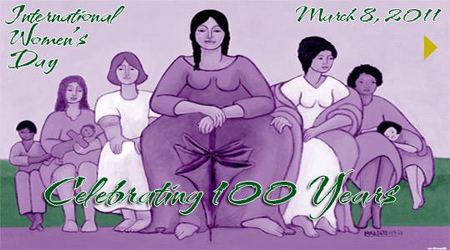Photos: International Women’s Day parade on Commercial Drive
March 5, 2011
Women in history: A timeline
Vancouver Sun
EXCERPTS only
1910: The National Council of Women go public in favour of suffrage.
1916: Between January and April, women in Manitoba won the right to vote in provincial elections followed by women in Saskatchewan, Alberta, British Columbia and Ontario.
1918: Women over 21 get the right to vote at the federal elections. Women also won the franchise in Nova Scotia.
1919: Women get the right to run for election to the House of Commons, and also get the right to vote in provincial elections in New Brunswick.
1921: Agnes Macphail was the first woman elected to the House of Commons.
1922: Right to vote in P.E.I. elections extended to women.
1925: Women in Newfoundland get the right to vote.
1927: The Supreme Court of Canada ruled that women are not “persons” under the law.
1929: The Famous Five appealed their case the Judicial Committee of the Privy Council in England and win. Women are declared “persons” under the law and qualify to be appointed to the Senate.
1934: Women in New Brunswick allowed to run for provincial office.
1940: Women in Quebec finally allowed to vote provincially.
1967: Royal Commission on the Status of Women launched.
1970: Report of the Royal Commission of the Status of Women is tabled.
1971: The first federal minister responsible for the status of women is appointed. Robert Andras is the first of seven men appointed to the position.
1972: Rosemary Brown became the first black women elected to provincial office in Canada. She was an MLA in B.C. for 14 years. 1986: The federal employment equity Act is passed.
International Women’s Day: 100 years of struggle for women’s liberation
By Judy Rebick
Rabble
March 7, 2011
The history of IWD is a history of the struggle of ordinary women to throw off the burden of the oppression and discrimination they faced. In 1908, 15,000 women marched through New York City demanding shorter hours, better pay and voting rights. The first National Women’s Day was celebrated in 1909 to demand right to vote, be trained, hold office and an end to discrimination on March 19.
Socialist women in Germany and Russia fought for an international women’s day to recognize the struggles of working-class women for better jobs, training and working conditions within the context of the fight for women’s suffrage and at the same time to push the socialist movement, massive at that time, to take seriously women’s demand for the vote and political participation. From the beginning, IWD was about a more inclusive women’s movement and a more feminist political movement.
In 1911, the first International Women’s Day marches were held across Europe. A few days later on March 25, 146 immigrant women were killed in the Triangle Factory fire because the bosses locked the doors from the outside. Russian socialist Alexander Kollentai proposed that the next year IWD would honour these women and the theme of IWD became bread and roses and the date March 8.
At the time, most women workers in Canada were domestic or textile workers. As soon as they got married or pregnant they were fired. They made up to 80% less than men for the same job. So the demand for bread was obvious.
As the song Bread and Roses, which has become an anthem of the women’s movement says, “Hearts starve as well as bodies, give us bread but give us roses.” The rose is a powerful symbol of the female and of love. That symbol comes not only from its beauty but also from its tenacity. ….
In Europe, women’s groups continued to celebrate but the IWD tradition was lost in North America even once a new generation challenged patriarchy in the late 60s and early 70s. On the 50th anniversary of IWD in 1960, delegates from women’s groups in 73 countries adopted a declaration for the political, economic and social rights of women. Then in 1975 the UN declared International Women’s Year and women’s liberation became official….
We have achieved a revolution in the status of women in the hundred years since IWD began. Our grandmothers who fought those early battles couldn’t even have imagined how much closer to liberation we are today. But we have not yet fully transformed the ancient system of patriarchy that continues to promote male domination, militarism and the objectification and oppression of women. That will take a new generation, of women and men, to take power out of the hands of the politicians, the corporations, including the media, and the experts, into their own hands and share it more equally and fairly.

BCGEU poster for IWD 2011
